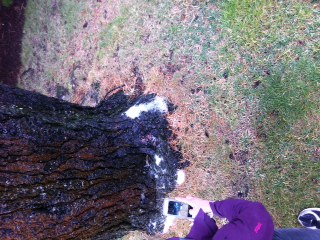
Foam at the base of a pine tree near Frost Hall, courtesy of Kate McMillan and Abby Stroven
Walking in the woods at Appleton Farms (Ipswich) with a class recently, I was soaked by seemingly unending rain. Our hardy group was out looking at vernal pools when several students asked me about foam at the bottom of several tree trunks. We saw that trickles of foam were coming down the trunks and piling at the base. What was the cause?
Then two staff members saw the same thing on campus and sent me a picture. I did not have an immediate answer for the cause of the foam, but I knew that sometimes foam forms in nature, and that it was not necessarily a problem. But just to be sure, I did some digging around.
Guess what? Foam forms on the trunks of trees in heavy rains because of chemical interactions similar to those that occur when you make soap. That is, it’s like a simple soap made in nature. On pine trees, foam forms because some of the chemicals found in pine sap are soap-like. On other trees, sometimes foam is formed from a chemical process that is created by the combination of air pollutants and plant materials. The air pollutants land on trees during dry periods and build up. During rains, they interact chemically, forming a soap and run down the trunks, foaming as it hits bumps in the bark. A similar process occurs on roads when rain occurs after a dry spell, leaving small pockets of foam by the edges of the road.
Sometimes, however, there is more foam than just the small amounts we saw this week. Foam can appear to pour out of a specific place in the trunk of a tree and down to the base. This is a sign of a bacterial disease called slime flux (also called foamy canker, alcoholic flux, or wetwood) . Trees that are stressed, especially by drought, can be weakened. Bacteria can get into damaged areas of the tree. Through wounds such as breaks in the bark. The bacteria break down tree tissue and produce alcohol and carbon dioxide. The gasses force themselves out of the wood, making a bubbling foam of sap and producing a wet area on the trunk. Sometimes insects such as bees come to feed on the alcohol mixture. If you wound a tree in your yard by hitting it with a lawn mower or weed whacker, the same problem can arise.
For more information on foam on trees see this
http://vtstateparks.blogspot.com/2012/05/whats-with-foam-i-saw-on-trees.html
and this:
http://en.allexperts.com/q/Plant-Diseases-715/white-foam-Oak-Tree.htm
